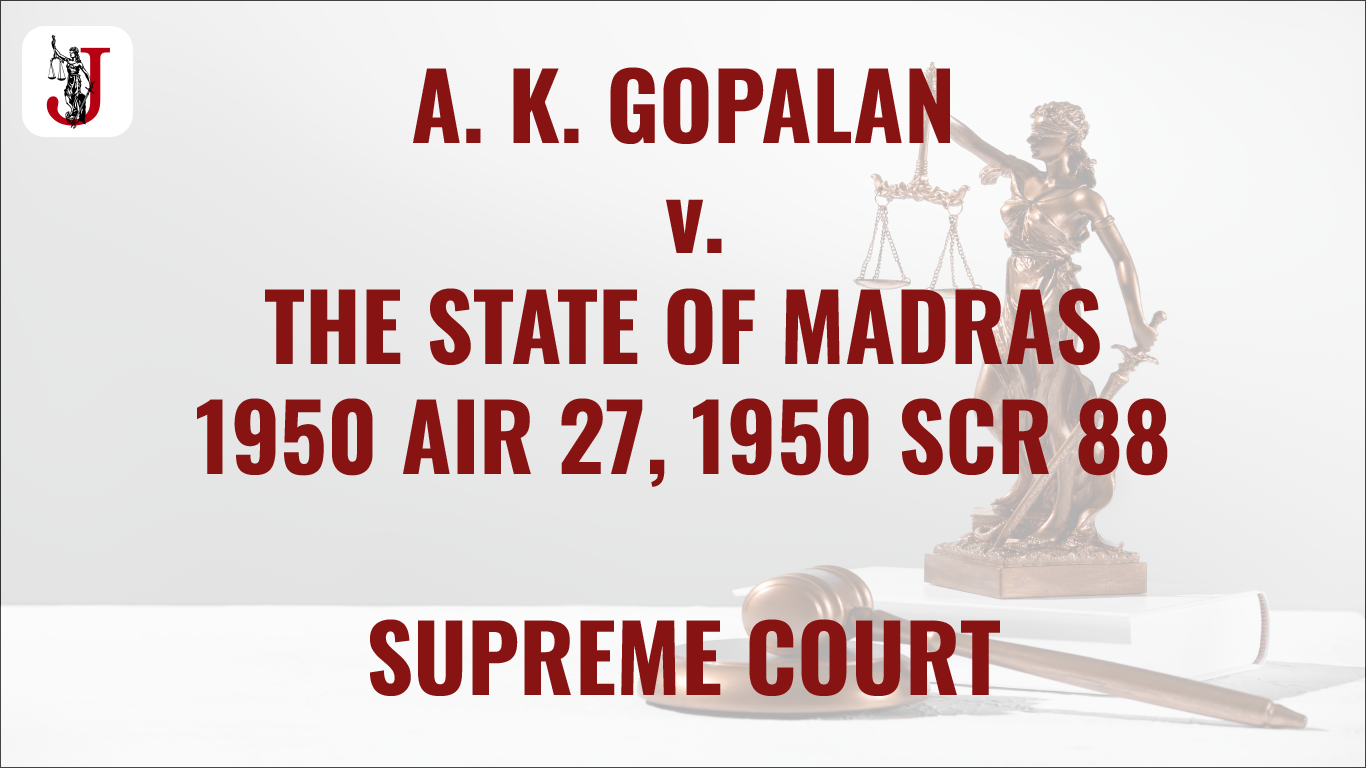1950 AIR 27, 1950 SCR 88
Introduction
This case is also known as the Preventive Detention Case, interpreted by the judiciary in connection with Article 21 of the Constitution.
Facts
Sri A. K. Gopalan, the then communist leader, was detained under Section 3(1) of the Preventive Detention Act, 1950.
This provision enabled the Central or the State Government to detain someone in order to prevent them from acting in a way that violates national defense, foreign relations, national security, state security, public order, or the maintenance of essential supplies and services.
The petitioner filed a writ petition under Article 32 of the Constitution to challenge the validity of this Act which violates fundamental rights given under Articles 13, 19, 21, and 22.
Issues
1. Whether the Preventive Detention Act of 1950 violates Articles 19 and 21 of the Constitution?
2. Whether a procedure established by law should be fair and reasonable?
Petitioner’s Argument
The petitioner contended that a law that takes away one’s life and liberty should be struck down by following the principles of natural justice.
The petitioner also submits that the preventive detention law affects the fundamental rights of the citizens, which are provided under Articles 19, 21, and 22.
The petitioner contended that fundamental rights can also be taken by due process of law, which is mentioned in US Constitution, where there must be a procedure established by law
Judgement
- The judgment in this case was delivered by a bench of six judges, where the majority opinion delivered the literal interpretation of Article 21 as the procedure established by law would simply mean to establish by the state.
- The court held that the Preventive Detention Act of 1950 does not violate Article 19 of the Constitution.
- The SC said that Article 19, which protects the freedom of citizens, does not apply to citizens whose freedom is already restricted by law, and thus there was no violation of Article 19(1).
- The SC struck down Section 14 of the Preventive Detention Act of 1950, as this section prevents the detainees from proving their innocence before the Court.
Doctrine of Severability
The Doctrine of Severability was first used in this case. The meaning of this doctrine is that if any portion or part of any act or law is against the basic structure of the constitution, then only that part of the law must be struck down; there is no need to strike down the full act or law.
Conclusion
In conclusion, it can be said that the judicial system of that time was mostly rigid in nature; that’s why they followed the literal interpretation of the constitution. Though the judiciary was rigid during that period of time, this case still holds a place in the history of the Supreme Court’s judgment.
Youtube facebook whatsapp web weather translate google amazon gmail google translate Instagram cricbuzz traductor Hotmail restaurants satta king tiempo twitter googel maps Yandex Sarkari result clima hotels fb yahoo maps chatgpt yahoo mail weather tomorrow Netflix roblox nba wordle tradutor livescore premier league ibomma speed test canva pintrest outlook Instagram login omegle flipkart myntra paypal paytm Alibaba ebay lottery sambad linkedin tiktok shein bbc news real madrid gmail login Walmart ikea cricket snaptik flashscore English to hindi twitch google scholar Barcelona Sarkari Naukri matrimonial shadi lgbtq third gender woman children Advocate barrister vakil supreme court high court commissioner exams ll.b ll.m ugc net law ph.d. m.b.a. graduation degree certificate school additional session judge civil judge justice jurists crime criminology punishment capital sentence death warrant fine constitution of india criminal procedure code civil procedure code evidence act sale of goods act arbitration act all india bar exam lower judiciary higher judiciary additional district attorney contract act amendment act u.s. constitution Canada p r section article schedule judgment vacancy post Porsche louis Vuitton chanel Gucci Hermes dior cartier rolex titan tiffany & co Ferrari estee lauder coach lancome burberry prada omega yves saint Laurent Lamborghini ray-ban Armani Moncler tata reliance Givenchy celine Bentley tag Heuer sk-II can cleef & arpels bulgari Shangri-la lao feng xiang dabur baidyanath cipla birla monte carlo loewe rolls-royce bottega-veneta jaege-leCoulture Maserati valentino dolce & gabbana Salvatore Ferragamo sulwhasso tom ford Maruti Suzuki Hyundai kia intercontinental Tissot aston martin ysl beauty fendi Versace kenzo la mer longines gold price sensex human rights pollution
